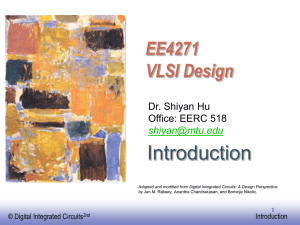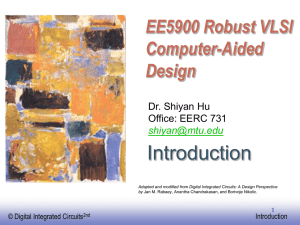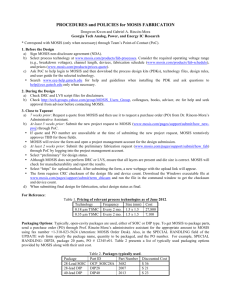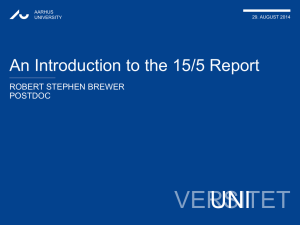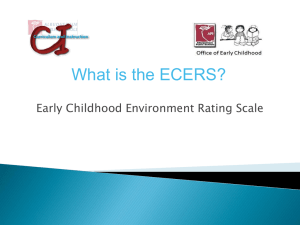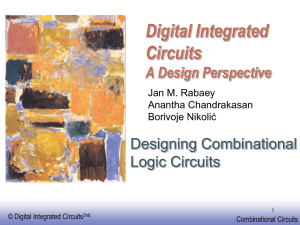powerpoint - Bears Ece Ucsb
advertisement
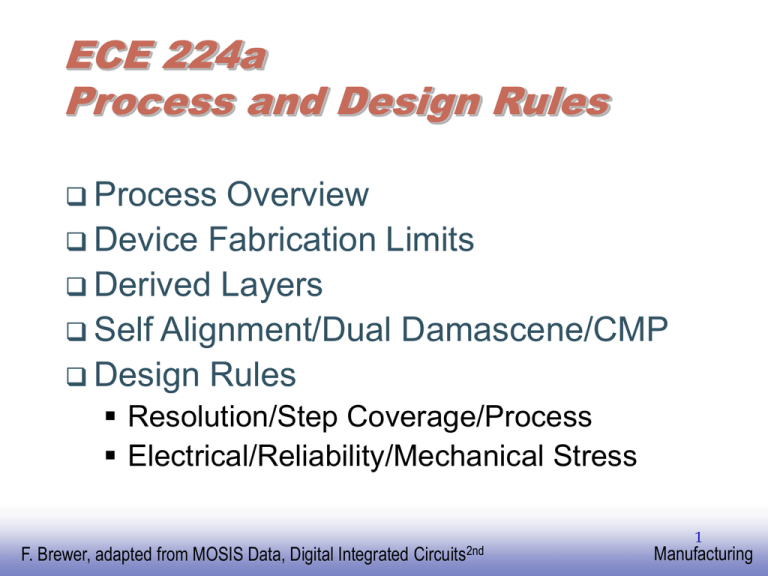
ECE 224a Process and Design Rules Process Overview Device Fabrication Limits Derived Layers Self Alignment/Dual Damascene/CMP Design Rules Resolution/Step Coverage/Process Electrical/Reliability/Mechanical Stress EE141 adapted from MOSIS Data, Digital Integrated F. Brewer, Circuits2nd 1 Manufacturing A Modern CMOS Process gate-oxide TiSi2 AlCu SiO2 Tungsten poly p-well n+ SiO2 n-well p+ p-epi p+ Dual-Well Trench-Isolated CMOS Process EE141 adapted from MOSIS Data, Digital Integrated F. Brewer, Circuits2nd 2 Manufacturing The Manufacturing Process Photo-Lithography Mask to Resist Resist to Pattern Layer Process (Implant/Etch/Oxide/Nitride/…) Cleanup (Clean/Planarization/Anneal) Setup next Layer for Processing For a great reference source: http://www.reed-electronics.com/semiconductor EE141 adapted from MOSIS Data, Digital Integrated F. Brewer, Circuits2nd 3 Manufacturing Photo-Lithographic Process optical mask oxidation photoresist removal (ashing) photoresist coating stepper exposure Typical operations in a single photolithographic cycle (from [Fullman]). photoresist development acid etch process step spin, rinse, dry EE141 adapted from MOSIS Data, Digital Integrated F. Brewer, Circuits2nd 4 Manufacturing Patterning of SiO2 Chemical or plasma etch Si-substrate Hardened resist SiO 2 (a) Silicon base material Si-substrate Photoresist SiO 2 Si-substrate (d) After development and etching of resist, chemical or plasma etch of SiO 2 Hardened resist SiO 2 (b) After oxidation and deposition of negative photoresist Si-substrate UV-light Patterned optical mask (e) After etching Exposed resist SiO 2 Si-substrate Si-substrate (c) Stepper exposure (f) Final result after removal of resist EE141 adapted from MOSIS Data, Digital Integrated F. Brewer, Circuits2nd 5 Manufacturing CMOS Process Walk-Through p-epi (a) Base material: p+ substrate with p-epi layer p+ SiN 34 p-epi SiO 2 (b) After deposition of gate-oxide and sacrificial nitride (acts as a buffer layer) p+ (c) After plasma etch of insulating trenches using the inverse of the active area mask p+ EE141 adapted from MOSIS Data, Digital Integrated F. Brewer, Circuits2nd 6 Manufacturing CMOS Process Walk-Through SiO 2 (d) After trench filling, CMP planarization, and removal of sacrificial nitride n (e) After n-well and V adjust implants Tp p EE141 adapted from MOSIS Data, Digital Integrated F. Brewer, (f) After p-well and V adjust implants Tn Circuits2nd 7 Manufacturing CMOS Process Walk-Through poly(silicon) (g) After polysilicon deposition and etch n+ p+ (h) After n+ source/drain and p+source/drain implants. These steps also dope the polysilicon. SiO 2 (i) After deposition of SiO insulator and contact hole2etch. EE141 adapted from MOSIS Data, Digital Integrated F. Brewer, Circuits2nd 8 Manufacturing CMOS Process Walk-Through Al (j) After deposition and patterning of first Al layer. Al SiO 2 (k) After deposition of SiO insulator, etching of via’s, 2 deposition and patterning of second layer of Al. EE141 adapted from MOSIS Data, Digital Integrated F. Brewer, Circuits2nd 9 Manufacturing Advanced Process Modules Generation Isolation Substrate Well Gate Dielectric Gate Gate Litho Junction Engineering Silicide BEOL Metal BEOL Dielectric 0.25um 0.18um 0.15um 0.13um 0.1um STI Bulk/Epi SOI option Retrograde --> Advanced SSR Multiple Gate Dielectric (Core/IO & Mixed-Signal) Dual Poly (n+/p+) Salicide DUV 248nm PSM 193nm PSM Advanced Junction/Pocket Engineering TiSix NiSix CoSix Al Al and Cu Cu Low-k (k=3.7) (K<3.0) (K<2.5) EE141 adapted from MOSIS Data, Digital Integrated F. Brewer, Circuits2nd 10 Manufacturing Lithography for 0.1um Node 80 nm Lines EE141 adapted from MOSIS Data, Digital Integrated F. Brewer, 120 nm Contact Holes Circuits2nd 11 Manufacturing Poly Gate Etch 100nm Experimental Simulation Pre-trim Trim X sec 50nm Trim X+20 sec Resist trimming is predictable by computer simulation as well as experiment. EE141 adapted from MOSIS Data, Digital Integrated F. Brewer, Circuits2nd 12 Manufacturing 12A Gate Oxide EE141 adapted from MOSIS Data, Digital Integrated F. Brewer, Circuits2nd 13 Manufacturing Advanced Metallization EE141 adapted from MOSIS Data, Digital Integrated F. Brewer, Circuits2nd 14 Manufacturing Interconnect RC Trend 1.20 Al/Low-k1 Normalized RC Cu/Low-k1 1.00 22% 0.80 Cu/Low-k1(Fixed L) Cu/Low-k1(Scaled L) CL013 Cu/Low-k2 CL013 Cu/Low-k2 Al/Low-k1(Fixed L) Al/Low-k1(Scaled L) 15% 0.60 0.40 CL013 CL015 CL018 Technology RC delay is evaluated at minimum M2 pitch EE141 adapted from MOSIS Data, Digital Integrated F. Brewer, Circuits2nd 15 Manufacturing Design Rules What can be fabricated? Resolution Limits – Light Source (357nm, 254nm, 193nm, ?) – Contact/Phase Masking – Surface State (Reflection/Scattering) Material Limits – Step Coverage – Porosity/Defect Propagation – Mechanical/Thermal Stress EE141 adapted from MOSIS Data, Digital Integrated F. Brewer, Circuits2nd 16 Manufacturing Design Rules II Electrical Limits – Electrical Fields (MV/cm)! – Parasitic Conductivity/Devices (Latchup/ESD) – Joule Heating (Electro-Migration) Defect Probability – Contact/Via Replication – Grid-Based Power/Ground Networks Advance Lithography – Rule Explosion/Failure of Locality – CMP Area Rules/Antenna Rules EE141 adapted from MOSIS Data, Digital Integrated F. Brewer, Circuits2nd 17 Manufacturing 85nm Poly Gate Profile 845A EE141 adapted from MOSIS Data, Digital Integrated F. Brewer, Circuits2nd 18 Manufacturing CL013 Core Device Technology Vcc CL013LV CL013G (14 ps/gate*) (20 ps/gate*) 1.0V 1.0V 1.2V 1.2V NMOS PMOS NMOS PMOS Lg (um) 0.08 0.085 0.12 0.12 Idsat(uA/um) 610 260 535 225 Vt(V) 0.3 0.3 0.34 0.34 Ioff(nA/um)** 10 10 1 1 BV(V) >2 >2 >2.4 >2.4 * Fanout = 1 ring oscillator ** room temp. & worst case. EE141 adapted from MOSIS Data, Digital Integrated F. Brewer, Circuits2nd 19 Manufacturing 0.13/0.18 Comparison Rule/Technology CL018 CL013 Shrink Ratio(% ) (unit: um) 1P6M 1P8M CL018 => CL013 0.86 0.62 72.0 OD (W/S) 0.22/0.28 0.15/0.21 72.0 Poly (W/S) 0.18/0.25 0.13/0.18 72.1 CO (W/S) 0.22/0.25 0.16/0.18 72.3 M1 (W/S) 0.23/0.23 0.16/0.18 73.9 Via1-Via (n-2) (W/S) 0.26/0.26 0.19/0.22 78.8 M2 ~ M(n-1) (W/S) 0.28/0.28 0.20/0.21 73.2 Via(n-1) (W/S) 0.36/0.35 0.36/0.35 100.0 Mn (W/S) 0.44/0.46 0.44/0.46 100.0 4.65 2.43 52.3 N+/P+ spacing 2 6T SRAM Cell (um ) * Please refer to shrinkage guideline for non-shrinkable details EE141 adapted from MOSIS Data, Digital Integrated F. Brewer, Circuits2nd 20 Manufacturing 3D Perspective Polysilicon EE141 adapted from MOSIS Data, Digital Integrated F. Brewer, Circuits2nd Aluminum 21 Manufacturing Poly-SiGe Gate Poly SiGe EE141 adapted from MOSIS Data, Digital Integrated F. Brewer, Circuits2nd 22 Manufacturing Design Rules III Interface twixt designer and process engineer Unit dimension: Minimum Feature Size scalable design rules: lambda absolute dimensions: (Vendor rules) Process Design Layers Derived Layers EE141 adapted from MOSIS Data, Digital Integrated F. Brewer, Circuits2nd 23 Manufacturing CMOS Process Design Layers Layer Color Well (p,n) Yellow Active Area (n+,p+) Green Select (p+,n+) Green Polysilicon Red Metal1 Blue Metal2 Magenta Metal3 Gold Contact to poly/diff Black Vias Black EE141 adapted from MOSIS Data, Digital Integrated F. Brewer, Representation Circuits2nd 24 Manufacturing Intra-Layer Design Rules Same Potential 0 or 6 Well Different Potential 3 18 Polysilicon 2 12 3 Active Contact or Via Hole 3 2 3 Metal1/2 2 2 3 3 Metal3 Select 5 EE141 adapted from MOSIS Data, Digital Integrated F. Brewer, Circuits2nd 25 Manufacturing Transistor Layout 3.1 FET length 2 (min) 3.2 FET spacing 3 3.3 Poly Overlap 2 3.4 Active Overlap 3 3.5 Space 1 EE141 adapted from MOSIS Data, Digital Integrated F. Brewer, Circuits2nd 26 Manufacturing Active Contact I 6.1 Size 2x2 6.2 Enclosure 1.5 6.3 Spacing 3 6.4 Space to FET 2 EE141 adapted from MOSIS Data, Digital Integrated F. Brewer, Circuits2nd 27 Manufacturing Poly Contact I 5.1 Size 2x2 5.2 Enclosure 1.5 5.3 Spacing 3 5.4 Space to FET 2 EE141 adapted from MOSIS Data, Digital Integrated F. Brewer, Circuits2nd 28 Manufacturing Via (m1 to m2) 9.1 Min Width 3 9.2.a Spacing 3 9.2.b Spacing 6 (width>10) 9.3 Enclosure 1 8.1 Size 2x2 8.2 Spacing 3 8.3 Enclosure 1 8.4 Space to Contact 2 8.5 Space to Poly/Act 2 EE141 adapted from MOSIS Data, Digital Integrated F. Brewer, Circuits2nd 29 Manufacturing Select Layer 2 6 N-Select 2 1 3 3 2 6 P-well EE141 adapted from MOSIS Data, Digital Integrated F. Brewer, N-well Circuits2nd 30 Manufacturing CMP Density Rules Chemical-Mechanical Polishing Requires uniform density of metal/poly SCMOS Rules: Poly 30% density across each 1mm2 area M1, M2 15% density M3 (top metal) is not restricted since no further polishing… EE141 adapted from MOSIS Data, Digital Integrated F. Brewer, Circuits2nd 31 Manufacturing Layout Guidelines I Group Transistors into Cells Plan inter-cell wires first (Sticks) Oversize Power Grids (Cell Default >6) Frequent Substrate Contacts/Well Plugs – Every Well (even one will kill design!) – Max distance to plug/contact 5-8 microns Set a large user grid e.g. 1-2 lambda Don’t optimize until you know the constraints Plan for Change and Optimization EE141 adapted from MOSIS Data, Digital Integrated F. Brewer, Circuits2nd 32 Manufacturing Electromigration (1) Limits dc-current to 1 mA/m EE141 adapted from MOSIS Data, Digital Integrated F. Brewer, Circuits2nd 33 Manufacturing Electromigration (2) EE141 adapted from MOSIS Data, Digital Integrated F. Brewer, Circuits2nd 34 Manufacturing Metal Migration Al (2.9Wcm M.P. 660 C) 1mA/m2 at 60C is average current limit for 10 year MTTF Current density decreases rapidly with temperature Cu (1.7Wcm M.P. 1060 C 10mA/m2 at 100C or better (depends on fabrication quality) Density decreases with temperature, but much slower over practical Silicon operation temperatures <120C Find Average current through wire – check cross section Circuits2nd EE141 adapted from MOSIS Data, Digital Integrated F. Brewer, Be wary of Via’s!! Typical cross-section: 35 Manufacturing 20-40% of Layout Guidelines II Current Limits 1 mA/m2 Avg. current limit (50C) – Strongly Temp Dependent (Al) – Failures typically occur at vias and contacts – Vias often Tungsten (higher resistance) Wide Wires need via arrays! Transistor Contacts Active is highly resistive Avoid High Density Currents EE141 adapted from MOSIS Data, Digital Integrated F. Brewer, Circuits2nd 36 Manufacturing Pads EE141 adapted from MOSIS Data, Digital Integrated F. Brewer, Circuits2nd 37 Manufacturing Pads-- Chip to Board Interface Pads drive large Capacitances 5pf minimum to much larger Rise time control Board Impeadance and Noise L dI/dt Noise Coupling to Power Distribution ESD EE141 adapted from MOSIS Data, Digital Integrated F. Brewer, Circuits2nd 38 Manufacturing Chip Packaging Bonding wire •Bond wires (~25m) are used to connect the package to the chip Chip L L Mounting cavity • Pads are arranged in a frame around the chip Lead Pin • Pads are relatively large (~100m in 0.25m technology), with large pitch (100m) •Many chips areas are ‘pad limited’ EE141 adapted from MOSIS Data, Digital Integrated F. Brewer, Circuits2nd 39 Manufacturing Pad Frame Layout EE141 adapted from MOSIS Data, Digital Integrated F. Brewer, Die Photo Circuits2nd 40 Manufacturing Pad Example EE141 adapted from MOSIS Data, Digital Integrated F. Brewer, Multiple busses provide clean/driver power VDD/GND pads drive the busses Output pads have protection circuitry and driver circuitry Input pads have protection circuitry Seal Ring Guard Rings Circuits2nd 41 Manufacturing Bus Detail EE141 adapted from MOSIS Data, Digital Integrated F. Brewer, Circuits2nd Multiple supply rings simplify pad design Generic Layout Simplifies custom tuning Guard Rings Between sections of pad ESD/Driver Controller 42 Manufacturing Seal Ring EE141 adapted from MOSIS Data, Digital Integrated F. Brewer, Seal Ring is essentially a guard ring with metal layers and contacts placed to lower overglass to substrate evenly at chip boundary Hermetic seal of chip from atmosphere and other contamination Circuits2nd 43 Manufacturing Pad Frame Large Power Busses Surround Die ESD in PADS Driver/Logic in Pads Seal Ring Drive Bypass EE141 adapted from MOSIS Data, Digital Integrated F. Brewer, Circuits2nd 44 Manufacturing Chip to Board Interface -- Pad Design Buffer to drive PCB-scale parasitics Capacitance 5-50pF, Impedance 30-90W Rise-Time Control Noise injection to circuits and power supply ESD Protection of chip-scale components Perimeter Pads/Area Bump EE141 adapted from MOSIS Data, Digital Integrated F. Brewer, Circuits2nd 45 Manufacturing Driving Large Capacitances V DD V in V out CL • Transistor Sizing • Cascaded Buffers EE141 adapted from MOSIS Data, Digital Integrated F. Brewer, Circuits2nd 46 Manufacturing Using Cascaded Buffers In Out 1 2 0.25 m process Cin = 2.5 fF tp0 = 30 ps N CL = 20 pF F = CL/Cin = 8000 fopt = 3.6 N = 7 tp = 0.76 ns (See Chapter 5) EE141 adapted from MOSIS Data, Digital Integrated F. Brewer, Circuits2nd 47 Manufacturing Output Driver Design Trade off Performance for Area and Energy Given tpmax find N and f Area f 1 F 1 A 1 f f ... f A A A f 1 f 1 2 N N 1 driver Energy min Edriver 1 f f 2 ... f N 1 C V EE141 adapted from MOSIS Data, Digital Integrated F. Brewer, i 2 DD min min F 1 C 2 2 CiVDD L VDD f 1 f 1 Circuits2nd 48 Manufacturing Delay as a Function of F and N 10,000 F = 10,000 tp/tp0 1000 0 t/p tp 100 F = 1000 10 1 3 5 7 F = 100 9 11 Number of buffer stages N EE141 adapted from MOSIS Data, Digital Integrated F. Brewer, Circuits2nd 49 Manufacturing Output Driver Design 0.25 m process, CL = 20 pF Transistor Sizes for optimally-sized cascaded buffer tp = 0.76 ns Transistor Sizes of redesigned cascaded buffer tp = 1.8 ns EE141 adapted from MOSIS Data, Digital Integrated F. Brewer, Circuits2nd 50 Manufacturing How to Design Large Transistors D(rain) Multiple Contacts Reduces diffusion capacitance Reduces gate resistance S(ource) G(ate) small transistors in parallel EE141 adapted from MOSIS Data, Digital Integrated F. Brewer, Circuits2nd 51 Manufacturing Bonding Pad Design Bonding Pad GND 100 m Out VDD In Out GND EE141 adapted from MOSIS Data, Digital Integrated F. Brewer, Circuits2nd 52 Manufacturing ESD Protection When a chip is connected to a board, there is unknown (potentially large) static voltage difference Equalizing potentials requires (large) charge flow through the pads Diodes sink this charge into the substrate – need guard rings to pick it up. EE141 adapted from MOSIS Data, Digital Integrated F. Brewer, Circuits2nd 53 Manufacturing ESD Protection V DD R D1 X PAD D2 C Diode EE141 adapted from MOSIS Data, Digital Integrated F. Brewer, Circuits2nd 54 Manufacturing Packaging EE141 adapted from MOSIS Data, Digital Integrated F. Brewer, Circuits2nd 55 Manufacturing Packaging Requirements Electrical: Low parasitics Mechanical: Reliable and robust Thermal: Efficient heat removal Economical: Cheap EE141 adapted from MOSIS Data, Digital Integrated F. Brewer, Circuits2nd 56 Manufacturing Bonding Techniques Wire Bonding Substrate Die Pad Lead Frame EE141 adapted from MOSIS Data, Digital Integrated F. Brewer, Circuits2nd 57 Manufacturing Tape-Automated Bonding (TAB) Sprocket hole Film + Pattern Solder Bump Die Test pads Lead frame Substrate (b) Die attachment using solder bumps. Polymer film (a) Polymer Tape with imprinted wiring pattern. EE141 adapted from MOSIS Data, Digital Integrated F. Brewer, Circuits2nd 58 Manufacturing Flip-Chip Bonding Die Solder bumps Interconnect layers Substrate EE141 adapted from MOSIS Data, Digital Integrated F. Brewer, Circuits2nd 59 Manufacturing Cu Flip-Chip Technology EE141 adapted from MOSIS Data, Digital Integrated F. Brewer, Circuits2nd 60 Manufacturing Package-to-Board Interconnect (a) Through-Hole Mounting (b) Surface Mount EE141 adapted from MOSIS Data, Digital Integrated F. Brewer, Circuits2nd 61 Manufacturing Package Types EE141 adapted from MOSIS Data, Digital Integrated F. Brewer, Circuits2nd 62 Manufacturing Package Parameters EE141 adapted from MOSIS Data, Digital Integrated F. Brewer, Circuits2nd 63 Manufacturing Multi-Chip Modules EE141 adapted from MOSIS Data, Digital Integrated F. Brewer, Circuits2nd 64 Manufacturing Lecture Problems 2 1. 2. 3. 4. 5. 6. Why is there a spacing rule between via’s and contacts and/or vias and other vias? How is it eliminated in deeper (smaller) processes? Draw a schematic and stick layout for a 3-input 2-output adder cell (output is sum and carry). Design as two cells: a cell producing ~Cout and another cell producing Sout(a,b,c,~Cout). Design Sue schematics and Max Layout for the two cells with minimum size transistors and turn in check plots. Guard Rings consist of n and p contact regions with continuous metal connections. They are often used to surround and isolate sensitive devices. How do they work? Very wide metal (any layer) in most technologies needs to have slots cut in it. Why? Explain the relation between CMP planarization and metal/poly density rules. Draw schematics and stick layouts for a 2 of 4 majority gate (true if two or more of its inputs are False). Do two designs, one to minimize transistors, and one where the inputs arrive in order:a,b,c,d last ti minimize the critical path. EE141 adapted from MOSIS Data, Digital Integrated F. Brewer, Circuits2nd 65 Manufacturing

